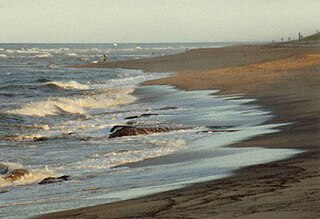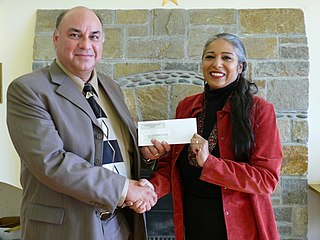
Cape Cod is a geographic cape extending into the Atlantic Ocean from the southeastern corner of mainland Massachusetts, in the northeastern United States. Its historic, maritime character and ample beaches attract heavy tourism during the summer months. The name Cape Cod, coined in 1602 by Bartholomew Gosnold, is the ninth oldest English place-name in the U.S.

The Abenaki are an Indigenous peoples of the Northeastern Woodlands of Canada and the United States. They are an Algonquian-speaking people and part of the Wabanaki Confederacy. The Eastern Abenaki language was predominantly spoken in Maine, while the Western Abenaki language was spoken in Quebec, Vermont, and New Hampshire.

Mashpee is a town in Barnstable County, Massachusetts, United States, on Cape Cod. The population was 15,060 as of 2020. The town is the site of the headquarters and most members of the Mashpee Wampanoag Tribe, one of two federally recognized Wampanoag groups.

Truro is a town in Barnstable County, Massachusetts, United States, comprising two villages: Truro and North Truro. Located slightly more than 100 miles (160 km) by road from Boston, it is a summer vacation community just south of the northern tip of Cape Cod, in an area known as the "Outer Cape". English colonists named it after Truro in Cornwall, United Kingdom.

A tipi, often called a lodge in English, is a conical tent, historically made of animal hides or pelts, and in more recent generations of canvas, stretched on a framework of wooden poles. The word is Siouan, and in use in Dakhótiyapi, Lakȟótiyapi, and as a loanword in US and Canadian English, where it is sometimes spelled phonetically as teepee and tepee.

The Wampanoag, also rendered Wôpanâak, are a Native American people. In the 17th century, they were a large confederation of at least twenty-four known and named tribes, but today Wampanoag people encompass five officially recognized tribes. The Mashpee Wampanoag Tribe and the Wampanoag Tribe of Gay Head in Massachusetts are federally recognized, and the Chappaquiddick Wampanoag Tribe, Herring Pond Wampanoag Tribe, Assawompsett-Nemasket Band of Wampanoags, and Pocasset Wampanoag Tribe are recognized by the Commonwealth of Massachusetts. They lived in southeastern Massachusetts and Rhode Island in the beginning of the 17th century, at the time of first contact with the English colonists, a territory that included the islands of Martha's Vineyard and Nantucket. Their population numbered in the thousands; 3,000 Wampanoag lived on Martha's Vineyard alone.

The Narragansett people are an Algonquian American Indian tribe from Rhode Island. Today, Narragansett people are enrolled in the federally recognized Narragansett Indian Tribe. They gained federal recognition in 1983.

The Massachusett language is an Algonquian language of the Algic language family, formerly spoken by several peoples of eastern coastal and southeastern Massachusetts. In its revived form, it is spoken in four communities of Wampanoag people. The language is also known as Natick or Wôpanâak (Wampanoag), and historically as Pokanoket, Indian or Nonantum.

The Algonquian are one of the most populous and widespread North American native language groups. Historically, the peoples were prominent along the Atlantic Coast and into the interior along the Saint Lawrence River and around the Great Lakes. This grouping consists of the peoples who speak Algonquian languages.

A wigwam, wickiup, wetu (Wampanoag), or wiigiwaam (Ojibwe) is a semi-permanent domed dwelling formerly used by certain Native American tribes and First Nations people and still used for ceremonial events. The term wickiup is generally used to refer to these kinds of dwellings in the Southwestern United States and Western United States and Northwest Alberta Canada, while wigwam is usually applied to these structures in the Northeastern United States as well as Ontario and Quebec in central Canada. The names can refer to many distinct types of Indigenous structures regardless of location or cultural group. The wigwam is not to be confused with the Native Plains teepee, which has a different construction, structure, and use.

The Nauset people, sometimes referred to as the Cape Cod Indians, were a Native American tribe who lived in Cape Cod, Massachusetts. They lived east of Bass River and lands occupied by their closely-related neighbors, the Wampanoag.

The Old Indian Meeting House is a historic meeting house at 410 Meetinghouse Road in Mashpee, Massachusetts. Built in 1684, the meetinghouse is the oldest Native American church in the eastern United States and the oldest church on Cape Cod. The building was listed on the National Register of Historic Places in 1998.

The Avant House, also known as the Timothy Pocknet Homestead is an historic house on Massachusetts Route 130 at Mill Pond in Mashpee, Massachusetts. Built in the late 18th or early 19th century, it is one of the town's oldest surviving buildings. It is now owned and operated by the Mashpee Wampanoag tribe as the Mashpee Wampanoag Indian Museum. It was listed on the National Register of Historic Places in 1998.

The Tomaquag Indian Memorial Museum is an Indigenous museum in Exeter, Rhode Island. The museum was founded by anthropologist Eva Butler and a Narragansett and Wampanoag woman named Princess Red Wing in the 1950s.
Cedric Cromwell, also known as Qaqeemasq in Wôpanâak, is the Former Tribal Council Chairman of the Mashpee Wampanoag Tribe of Massachusetts. Elected in 2009 as chairman, Cedric Cromwell was the head of the official elected government for the 2,600-member federally recognized tribe.
The Mashpee Wampanoag Tribe is one of two federally recognized tribes of Wampanoag people in Massachusetts. Recognized in 2007, they are headquartered in Mashpee on Cape Cod. The other Wampanoag tribe is the Wampanoag Tribe of Gay Head (Aquinnah) on Martha's Vineyard.
Paula Peters is a journalist, educator and activist. A member of the Wampanoag tribe, she has spent most of her life in her tribal homeland of Mashpee, Massachusetts. She hails from a prominent Mashpee Wampanoag family, including Tribal Chairman Russell "Fast Turtle" Peters, and was active in the tribe's long and contested push for federal recognition. In a 2006 interview with NPR, Peters recalled a time when "nobody in Washington cared much about which tribes were recognized." Like her father before her, Peters served on the Mashpee Wampanoag Tribal Council. In 2005, she ran against Glenn Marshall for Council Chairperson.
The Massachusett dialects, as well as all the Southern New England Algonquian (SNEA) languages, could be dialects of a common SNEA language just as Danish, Swedish and Norwegian are mutually intelligible languages that essentially exist in a dialect continuum and three national standards. With the exception of Massachusett, which was adopted as the lingua franca of Christian Indian proselytes and survives in hundreds of manuscripts written by native speakers as well as several extensive missionary works and translations, most of the other SNEA languages are only known from fragmentary evidence, such as place names. Quinnipiac (Quiripey) is only attested in a rough translation of the Lord's Prayer and a bilingual catechism by the English missionary Abraham Pierson in 1658. Coweset is only attested in a handful of lexical items that bear clear dialectal variation after thorough linguistic review of Roger Williams' A Key into the Language of America and place names, but most of the languages are only known from local place names and passing mention of the Native peoples in local historical documents.
Massachusett Pidgin or Massachusett Jargon was a contact pidgin or auxiliary language derived from the Massachusett language attested in the earliest colonial records up until the mid-eighteenth century. Little is known about the language, but it shared a much simplified grammatical system, with many features similar to the better attested Delaware Jargon spoken in the nearby Hudson and Delaware watersheds. It was mutually intelligible with the other Southern New England Algonquian languages.

Massachusett Pidgin English was an English-based contact language that had developed in early seventeenth century New England and Long Island as a medium of communication between the Native speakers of Algonquian languages and the English settlers that began to settle the coastal areas in 1620s. The use of Massachusett Pidgin English co-existed in Massachusett-speaking communities with their original dialects as well as Massachusett Pidgin, another contact language that was Massachusett-based. Unlike Massachusett Pidgin, which was confused with the Massachusett language by the English colonists, attestations of Massachusett Pidgin English are quite numerous. As few of the colonists were able to or willing to master either Massachusett or its Pidgin variety, those that traded and lived directly next to Indian villages communicated in Massachusett Pidgin English. The use of Massachusett Pidgin English supplanted the use of Massachusett Pidgin and likely even overtook the native language in community. In a process likely to decreolization, the speakers of Massachusett Pidgin English began to adjust their language to the English of their neighbors, and since the nineteenth century, all the descendants of the Massachusett-speaking peoples have been monolingual English speakers.













